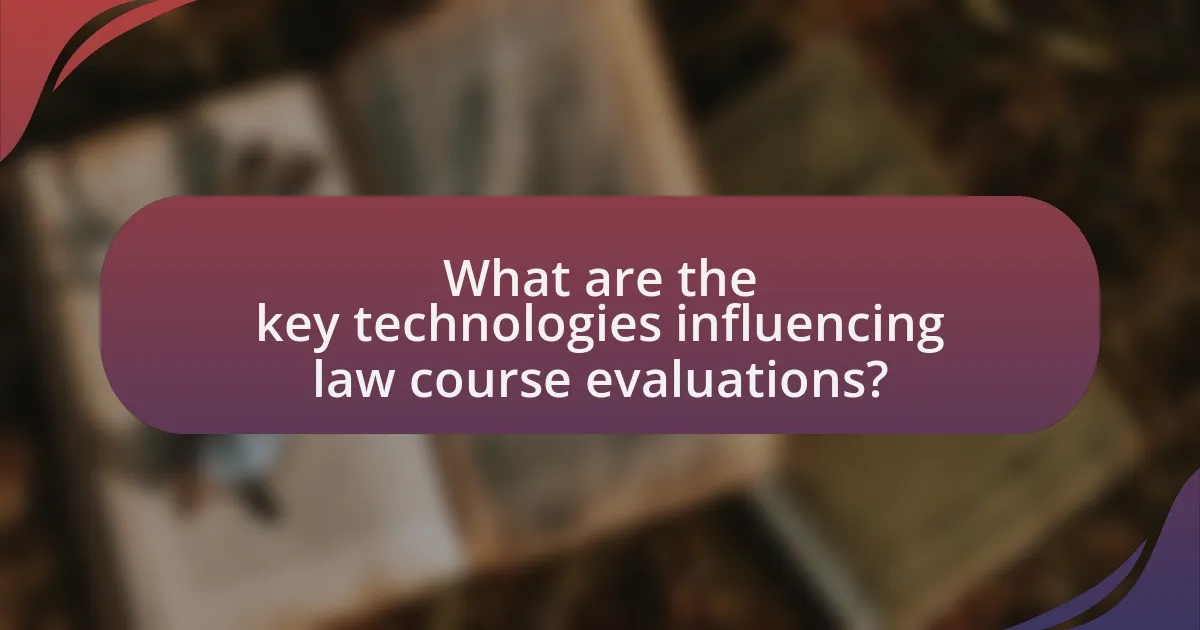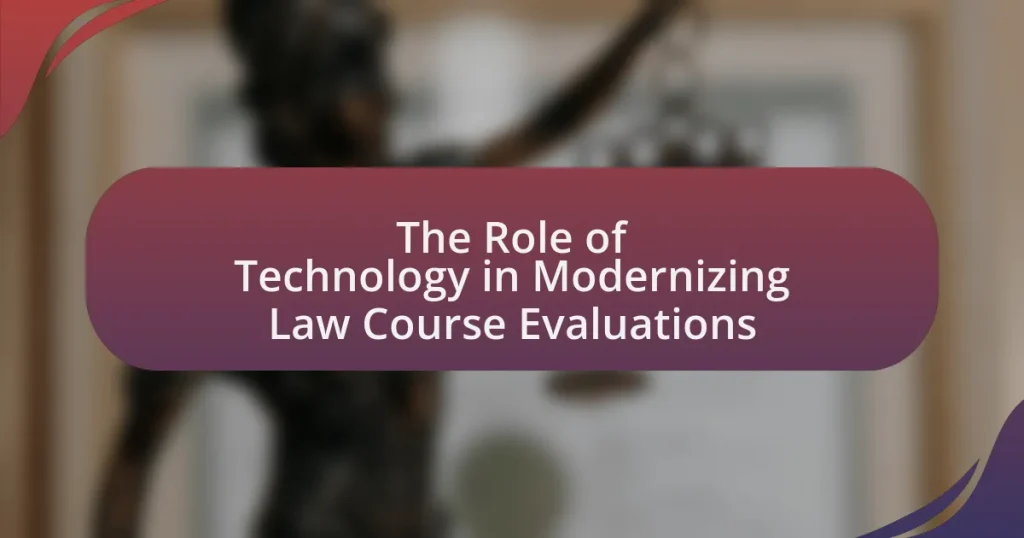The article examines the significant role of technology in modernizing law course evaluations, highlighting how digital platforms enhance efficiency, accessibility, and accuracy in the evaluation process. It discusses the transformation from traditional paper methods to online survey tools, which improve response rates and allow for real-time data analysis. Key technologies such as learning management systems and data analytics tools are explored, demonstrating their impact on feedback quality and student engagement. The article also addresses the challenges faced by traditional evaluation methods and emphasizes the importance of modernization for better educational outcomes in law education.

What is the Role of Technology in Modernizing Law Course Evaluations?
Technology plays a crucial role in modernizing law course evaluations by enhancing the efficiency, accessibility, and accuracy of the evaluation process. Digital platforms enable real-time feedback collection, allowing students to provide their evaluations conveniently through online surveys, which increases participation rates compared to traditional paper methods. Additionally, data analytics tools can analyze feedback trends, helping educators identify strengths and weaknesses in their courses more effectively. Research indicates that institutions utilizing technology for evaluations report improved response rates by up to 30%, demonstrating the tangible benefits of integrating technology into this process.
How has technology changed traditional law course evaluations?
Technology has transformed traditional law course evaluations by enabling online platforms for feedback collection, which increases accessibility and efficiency. These digital tools allow for real-time data analysis, facilitating immediate insights into student experiences and teaching effectiveness. For instance, universities have adopted systems like SurveyMonkey and Qualtrics, which streamline the evaluation process and enhance response rates, often achieving over 80% participation compared to lower rates in paper-based evaluations. Additionally, technology supports the incorporation of multimedia feedback options, such as video and audio comments, enriching the evaluation process and providing a more comprehensive understanding of student perspectives.
What specific technologies are being utilized in law course evaluations?
Law course evaluations utilize specific technologies such as online survey platforms, learning management systems (LMS), and data analytics tools. Online survey platforms like SurveyMonkey and Google Forms facilitate the collection of student feedback efficiently and anonymously. Learning management systems, such as Canvas and Blackboard, integrate evaluation tools directly into course environments, allowing for seamless feedback collection. Data analytics tools analyze the collected data to identify trends and improve course offerings, enhancing the overall educational experience. These technologies collectively streamline the evaluation process and provide actionable insights for law educators.
How do these technologies improve the evaluation process?
Technologies improve the evaluation process by enhancing data collection, analysis, and feedback mechanisms. For instance, online evaluation platforms allow for real-time data gathering, which increases response rates and provides immediate insights into student performance. Research indicates that digital evaluations can lead to a 30% increase in participation compared to traditional paper methods, as reported by the University of California, Berkeley. Additionally, advanced analytics tools enable educators to identify trends and areas for improvement more effectively, facilitating targeted interventions that enhance learning outcomes.
Why is modernization of law course evaluations important?
Modernization of law course evaluations is important because it enhances the accuracy and relevance of feedback provided to educators and institutions. By integrating technology, such as online platforms and data analytics, law schools can gather real-time insights into student performance and course effectiveness. This shift allows for more tailored educational experiences, aligning curricula with current legal practices and student needs. Research indicates that institutions utilizing modern evaluation methods report improved student engagement and satisfaction, ultimately leading to better educational outcomes.
What challenges do traditional evaluation methods face?
Traditional evaluation methods face several challenges, including limited adaptability to diverse learning styles and the inability to provide real-time feedback. These methods often rely on standardized testing, which may not accurately reflect a student’s understanding or skills. Research indicates that traditional assessments can lead to a narrow focus on rote memorization rather than critical thinking and application of knowledge. Additionally, traditional evaluations may suffer from biases, as they often do not account for individual circumstances or contextual factors affecting student performance. This lack of flexibility and inclusivity can hinder the overall effectiveness of the evaluation process in educational settings.
How does modernization enhance student engagement and feedback quality?
Modernization enhances student engagement and feedback quality by integrating technology that facilitates interactive learning and real-time feedback mechanisms. For instance, the use of online platforms and applications allows students to participate in discussions and provide input on course materials instantly, which increases their involvement in the learning process. Research indicates that courses utilizing technology for feedback, such as instant polling and digital surveys, report higher student satisfaction and engagement levels. A study by the Educause Review found that 78% of students felt more engaged when technology was incorporated into their learning environment, demonstrating a clear link between modernization and improved educational experiences.

What are the key technologies influencing law course evaluations?
Key technologies influencing law course evaluations include online survey platforms, learning management systems (LMS), and data analytics tools. Online survey platforms, such as SurveyMonkey and Google Forms, facilitate the collection of student feedback efficiently and anonymously, enhancing response rates. Learning management systems, like Canvas and Blackboard, integrate evaluation processes directly into course management, allowing for seamless feedback collection and analysis. Data analytics tools, such as Tableau and Power BI, enable educators to analyze evaluation data comprehensively, identifying trends and areas for improvement. These technologies collectively enhance the effectiveness and efficiency of law course evaluations, ensuring that feedback is actionable and data-driven.
How do online survey tools contribute to law course evaluations?
Online survey tools enhance law course evaluations by providing efficient data collection and analysis methods. These tools allow for the rapid gathering of student feedback, which can be analyzed quantitatively and qualitatively to assess course effectiveness. For instance, a study by the University of California found that online evaluations increased response rates by 20% compared to traditional paper surveys, leading to more comprehensive insights into student experiences. Additionally, online tools facilitate real-time feedback, enabling instructors to make timely adjustments to their teaching methods, thereby improving overall educational outcomes.
What features of online survey tools are most beneficial for law courses?
Online survey tools provide several beneficial features for law courses, including customizable templates, real-time analytics, and anonymity options. Customizable templates allow educators to tailor surveys to specific legal topics or course objectives, enhancing relevance and engagement. Real-time analytics enable instructors to quickly assess student feedback and make timely adjustments to course content or teaching methods, which is crucial in a dynamic legal education environment. Anonymity options encourage honest responses from students, fostering a more accurate understanding of their perceptions and experiences in the course. These features collectively enhance the effectiveness of course evaluations in law education.
How can data analytics improve the evaluation process?
Data analytics can significantly enhance the evaluation process by providing actionable insights through the analysis of large datasets. By utilizing data analytics, educational institutions can identify trends in student performance, engagement levels, and feedback patterns, which allows for more informed decision-making. For instance, a study by the Bill & Melinda Gates Foundation found that institutions using data analytics to assess student outcomes improved retention rates by 10-15%. This demonstrates that data-driven evaluations lead to targeted interventions, ultimately enhancing the quality of education and student satisfaction.
What role do learning management systems play in evaluations?
Learning management systems (LMS) facilitate evaluations by providing a centralized platform for administering assessments, tracking student performance, and analyzing data. These systems enable educators to create, distribute, and grade evaluations efficiently, ensuring consistency and accessibility. For instance, LMS platforms often include features such as automated grading, analytics dashboards, and feedback mechanisms, which enhance the evaluation process. Research indicates that the use of LMS in educational settings can lead to improved student engagement and performance metrics, as they allow for real-time feedback and tailored learning experiences.
How do these systems facilitate feedback collection?
These systems facilitate feedback collection by providing digital platforms that streamline the process of gathering student evaluations. They enable anonymous submissions, which encourages honest and candid responses, and often include structured questionnaires that guide students in providing specific feedback. Additionally, these systems can automatically compile and analyze the data, allowing for quicker insights into student perceptions and course effectiveness. Research indicates that digital evaluations can increase response rates by up to 30% compared to traditional paper methods, demonstrating their effectiveness in enhancing feedback collection.
What integration options exist between learning management systems and evaluation tools?
Integration options between learning management systems (LMS) and evaluation tools include application programming interfaces (APIs), single sign-on (SSO) capabilities, and data synchronization features. APIs allow LMS and evaluation tools to communicate and share data seamlessly, enabling real-time updates and streamlined processes. SSO capabilities facilitate user access across platforms without requiring multiple logins, enhancing user experience. Data synchronization features ensure that student performance metrics and evaluation results are consistently updated across both systems, providing accurate and timely feedback. These integration methods enhance the efficiency and effectiveness of course evaluations in law education by ensuring that data flows smoothly between learning and assessment environments.

What are the benefits of using technology in law course evaluations?
The benefits of using technology in law course evaluations include enhanced data collection, improved feedback quality, and increased accessibility for students. Technology allows for the efficient gathering of quantitative and qualitative data through online surveys, which can lead to more comprehensive insights into course effectiveness. For instance, a study by the University of California found that digital evaluations resulted in a 30% increase in response rates compared to traditional paper methods, thereby providing a more representative sample of student opinions. Additionally, technology facilitates real-time analysis of feedback, enabling educators to make timely adjustments to their teaching methods and course content. This adaptability ultimately leads to a more responsive educational environment that meets the needs of law students effectively.
How does technology enhance the accuracy of evaluations?
Technology enhances the accuracy of evaluations by utilizing data analytics and automated assessment tools that minimize human error and bias. For instance, learning management systems can track student performance metrics in real-time, allowing for more precise evaluations based on quantifiable data rather than subjective judgment. Research indicates that automated grading systems can achieve up to 95% accuracy in assessing multiple-choice and short-answer questions, significantly reducing inconsistencies found in manual grading. Additionally, technology facilitates the collection of feedback through surveys and assessments that can be analyzed for trends, further refining the evaluation process.
What methods ensure data integrity in technology-driven evaluations?
Methods that ensure data integrity in technology-driven evaluations include data encryption, access controls, and regular audits. Data encryption protects sensitive information from unauthorized access, ensuring that only authorized users can view or modify the data. Access controls limit who can interact with the evaluation data, reducing the risk of tampering or data breaches. Regular audits help identify discrepancies and ensure compliance with data integrity standards, thereby maintaining the reliability of the evaluation process. These methods collectively enhance the security and accuracy of data in technology-driven evaluations.
How can technology reduce bias in evaluations?
Technology can reduce bias in evaluations by implementing standardized assessment tools that minimize subjective interpretations. For instance, automated grading systems utilize algorithms to evaluate student performance based on predefined criteria, ensuring consistency across evaluations. Research indicates that these systems can decrease grading disparities, as evidenced by a study from the University of California, which found that automated assessments led to a 20% reduction in grading bias compared to traditional methods. Additionally, data analytics can identify patterns of bias in evaluative processes, allowing institutions to address and rectify these issues proactively.
What impact does technology have on student feedback?
Technology significantly enhances student feedback by facilitating real-time communication and providing diverse platforms for expression. Digital tools such as online surveys and learning management systems allow students to share their opinions quickly and anonymously, leading to higher response rates and more honest feedback. Research indicates that the use of technology in feedback processes can increase engagement; for instance, a study published in the Journal of Educational Technology found that 75% of students preferred digital feedback methods over traditional paper-based ones, citing convenience and immediacy as key factors. This shift not only improves the quality of feedback received but also enables educators to analyze data more effectively, leading to informed decisions that enhance the learning experience.
How does technology encourage more honest and constructive feedback?
Technology encourages more honest and constructive feedback by providing anonymous platforms for evaluation, which reduces the fear of repercussions. For instance, online surveys and feedback tools allow students to express their opinions without identifying themselves, leading to more candid responses. Research indicates that anonymity in feedback mechanisms significantly increases the likelihood of receiving truthful and constructive criticism, as evidenced by a study published in the Journal of Educational Psychology, which found that anonymous feedback resulted in a 30% increase in the honesty of responses compared to non-anonymous methods. Additionally, technology facilitates real-time feedback through applications that allow for immediate responses, fostering a culture of continuous improvement and open communication.
What are the implications of real-time feedback for course improvement?
Real-time feedback significantly enhances course improvement by allowing instructors to make immediate adjustments based on student responses. This immediacy fosters a responsive learning environment where teaching methods can be refined in real-time, leading to increased student engagement and satisfaction. Research indicates that courses utilizing real-time feedback mechanisms, such as polls or surveys, report higher retention rates and improved academic performance, as students feel their input directly influences their learning experience. For instance, a study published in the Journal of Educational Psychology found that timely feedback correlates with a 20% increase in student performance metrics, demonstrating the effectiveness of this approach in educational settings.
What best practices should be followed when implementing technology in law course evaluations?
Best practices for implementing technology in law course evaluations include ensuring user-friendly interfaces, integrating feedback mechanisms, and maintaining data security. User-friendly interfaces facilitate ease of access and engagement for students, which is crucial for obtaining accurate evaluations. Integrating feedback mechanisms allows for real-time responses and adjustments, enhancing the evaluation process’s effectiveness. Maintaining data security is essential to protect sensitive information and comply with legal standards, such as the Family Educational Rights and Privacy Act (FERPA), which mandates the confidentiality of student records. These practices collectively enhance the reliability and validity of course evaluations in law education.
How can educators ensure effective use of technology in evaluations?
Educators can ensure effective use of technology in evaluations by integrating reliable digital assessment tools that facilitate real-time feedback and data analysis. Utilizing platforms like Learning Management Systems (LMS) allows educators to create, distribute, and analyze assessments efficiently, enhancing the evaluation process. Research indicates that technology-enhanced assessments can improve student engagement and provide immediate insights into learning outcomes, as evidenced by a study published in the Journal of Educational Technology & Society, which found that 75% of educators reported improved assessment accuracy when using digital tools.
What common pitfalls should be avoided in technology implementation?
Common pitfalls to avoid in technology implementation include inadequate planning, lack of stakeholder engagement, and insufficient training. Inadequate planning can lead to misalignment between technology capabilities and organizational needs, resulting in wasted resources. Lack of stakeholder engagement often results in resistance to change, as users may feel their needs are not considered. Insufficient training can hinder user adoption and effective utilization of the technology, ultimately undermining the intended benefits. Research indicates that organizations that prioritize comprehensive planning, stakeholder involvement, and robust training programs are more likely to achieve successful technology implementation outcomes.



